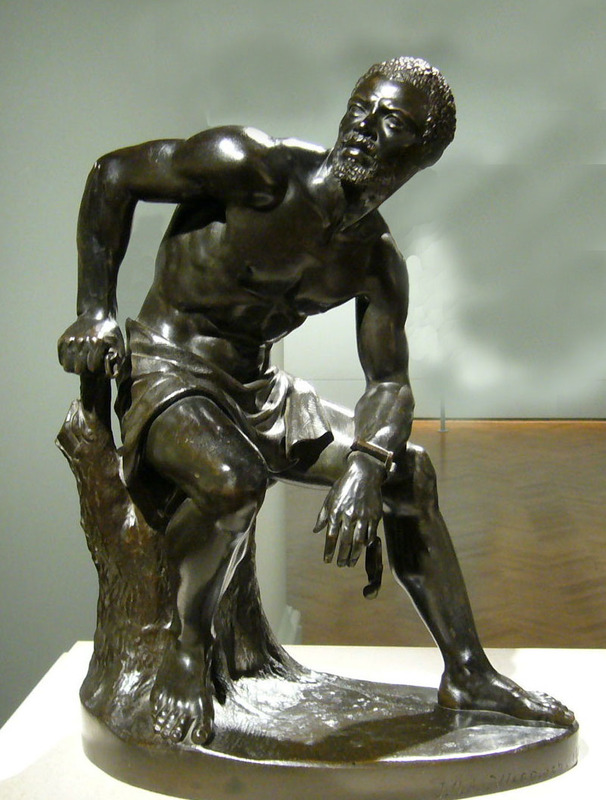"Ward's Statuette of the 'Freedman,'" New York Times, November 19, 1864
 In 1863, several months following the Emancipation Proclamation, a two-foot high plaster statue by a young sculptor named John Quincy Adams Ward was exhibited in New York. The figure of an escaped male slave, entitled Freedman, was noteworthy for its classical style and commanding presence—a striking departure from the image of the beseeching, kneeling African American made familiar by the antislavery movement. Subsequently cast in bronze and sold to a small group of subscribers, Ward's Freedman seemed to mark a new way of sculpting the African American figure and there was a brief effort to promote the adaptation of the statue into a public monument. This 1864 New York Times article indicates the enthusiasm the work engendered. But Freedman's popularity was shortlived and it turned out to be unique in nineteenth-century U.S. sculpture.
In 1863, several months following the Emancipation Proclamation, a two-foot high plaster statue by a young sculptor named John Quincy Adams Ward was exhibited in New York. The figure of an escaped male slave, entitled Freedman, was noteworthy for its classical style and commanding presence—a striking departure from the image of the beseeching, kneeling African American made familiar by the antislavery movement. Subsequently cast in bronze and sold to a small group of subscribers, Ward's Freedman seemed to mark a new way of sculpting the African American figure and there was a brief effort to promote the adaptation of the statue into a public monument. This 1864 New York Times article indicates the enthusiasm the work engendered. But Freedman's popularity was shortlived and it turned out to be unique in nineteenth-century U.S. sculpture.Transcription: We welcome with great interest the appearance of Ward’s statuette of the “Freedman” in bronze now on exhibition in Goupil’s gallery. For more than a year we have patiently awaited its reproduction in some permanent material: and if so much time was necessary to produce it in its present form, we do not regret it, for certainly it is a triumph mechanically as well as artistically – the casting and chasing being as fine as could have been done even in Europe. To those who have had an opportunity of seeing the model, the perfect fitness of the material to the subject will be apparent—the very color seeming to add to its sentiment and reality. It is very gratifying to come back again with fresh eyes to this admirable statuette and discover new thoughts and beauties, and to be able better to comprehend the power, knowledge and (we may say here without missing that oft misapplied word) genius that created such a work. This figure is true to the negro type, not only in feature, but in pose and anatomical structure—true also in character, the attitude of a man fatigued from effort or struggle—in hope, watchful and determined, the right hand grasping his broken manacle, is significant—that strong purpose, backed by his magnificent physique, would deter any slave-catcher from laying hands on him. The author of “Art Ideas” says of this work: “It is completely original in itself—a genuine inspiration of American history, noble in thought and lofty in sentiment. It symbolizes the African race in America, the birthday of a new people into the ranks of Christian civilization; we have seen nothing in sculpture more soul-lifting or more comprehensively eloquent. It tells the whole sad tale of slavery and the bright story of emancipation. The negro is true to his type—of naturalistic fidelity of limbs; in form and strength suggesting the colossal, and yet of an ideal beauty, made divine by the divinity of art.” It is to be regretted that the cost of this work in bronze must necessarily limit the number of copies, as it should be seen and possessed by the great mass of the people. Why cannot we have copies in clay-colored material? It would fill a great want in our available sculpture—something to educate the people, to point out the legitimate province of that dignified art, of which Mr. Ward is one of the most illustrious and honored disciples.
Source: American Social History Project / Image: en.wikipedia.org/wiki/File:WardSlave.jpg
Publisher: New York Times
Date: November 19, 1864



